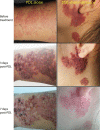Topical Halometasone Reduces Acute Adverse Effects Induced by Pulsed Dye Laser for Treatment of Port Wine Stain Birthmarks
- PMID: 29399306
- PMCID: PMC5775950
- DOI: 10.15171/jlms.2018.05
Topical Halometasone Reduces Acute Adverse Effects Induced by Pulsed Dye Laser for Treatment of Port Wine Stain Birthmarks
Abstract
Introduction: Pulsed dye laser (PDL) for treatment of port wine stain (PWS) usually causes some acute adverse effects, including pain, erythema, scabbing and swelling. This study aimed to determine whether topical halometasone can be used to reduce these acute adverse effects for post-PDL care of patients. Methods: A total of 40 PWS subjects were enrolled in this study and randomly assigned into two regimens: PDL alone and PDL + halometasone. All subjects were given a single treatment of PDL with wavelength of 595 nm, fluence of 8.0~13.5 J/cm2, pulse duration of 0.45~20 ms (We mainly used purpuric pulse duration for PWS) and spot size of 7 mm. Subjects in the PDL + halometasone group received topical application of halometasone daily for 3 days. Subjects were followed-up on days 3, 7 and one month post-PDL to evaluate the reduction of adverse effects. Results: Subjects in the PDL + halometasone group had significantly improved erythema and scab scores and had less erythema duration days as compared to those in the PDL alone group. Topical halometasone also showed a decrease in pain index among subjects, but was statistically insignificant. Topical halometasone did not affect the ultimate efficacy of PDL treatment for PWS. Conclusion: Topical halometasone can significantly reduce acute adverse effects induced by PDL for treatment of PWS birthmarks, thus providing a safe and efficacious solution for post-PDL care of PWS patients.
Keywords: Adverse effects; Halometasone; Port wine stain; Pulsed dye laser.
Similar articles
-
Pilot study examining the combined use of pulsed dye laser and topical Imiquimod versus laser alone for treatment of port wine stain birthmarks.Lasers Surg Med. 2008 Nov;40(9):605-10. doi: 10.1002/lsm.20716. Lasers Surg Med. 2008. PMID: 18951427 Free PMC article.
-
Port wine stain treated with a combination of pulsed dye laser and topical rapamycin ointment.Lasers Surg Med. 2016 Feb;48(2):193-6. doi: 10.1002/lsm.22436. Epub 2015 Oct 26. Lasers Surg Med. 2016. PMID: 26503090
-
EMLA cream does not influence efficacy and pain reduction during pulsed-dye laser treatment of port-wine stain: a prospective side-by-side comparison.Lasers Med Sci. 2018 Apr;33(3):573-579. doi: 10.1007/s10103-017-2415-3. Epub 2017 Dec 15. Lasers Med Sci. 2018. PMID: 29247433 Clinical Trial.
-
Topical Adjuncts to Pulsed Dye Laser for Treatment of Port Wine Stains: Review of the Literature.Dermatol Surg. 2018 Jun;44(6):796-802. doi: 10.1097/DSS.0000000000001507. Dermatol Surg. 2018. PMID: 29799824 Review.
-
Treatment of pulsed dye laser-resistant port wine stain birthmarks.J Am Acad Dermatol. 2007 Oct;57(4):677-82. doi: 10.1016/j.jaad.2007.01.019. Epub 2007 Jul 19. J Am Acad Dermatol. 2007. PMID: 17658196 Review.
Cited by
-
Complication rates and safety of pulsed dye laser treatment for port-wine stain: a systematic review and meta-analysis.Lasers Med Sci. 2023 Dec 23;39(1):16. doi: 10.1007/s10103-023-03961-5. Lasers Med Sci. 2023. PMID: 38141129
References
-
- Mulliken JB, Young AR, Eds. Vascular Birthmarks--Hemangiomas and Malformations. Philadelphia: W. B. Saunders Co; 1988.
-
- Jacobs AH, Walton RG. The incidence of birthmarks in the neonate. Pediatrics. 1976;58(2):218–222. - PubMed
-
- Malm M, Carlberg M. Port-wine stain--a surgical and psychological problem. Ann Plast Surg. 1988;20(6):512–516. - PubMed
LinkOut - more resources
Full Text Sources
Other Literature Sources

